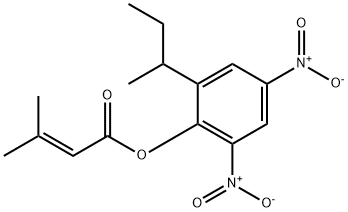Description
Binapacryl is a nitrophenol pesticide and thedimethyl acrylic ester of dinoseb. Binapacryl is a colorless,crystalline solid or powder. Crystals may turn pale-yellowto brownish on contact with air. The solid may be dissolved in a flammable liquid carrier. Mild, ammonia odor.Molecular weight=322.31; Density=1.238 g/cm3 at20℃. Melting/Freezing=66℃; Boiling Point=437℃ at760 mmHg; Vapor pressure=4.2 3 10 2 7 mmHg at 20℃;Flash point=172℃; but may be dissolved in a flammableliquid carrier. Practically insoluble in water.
Uses
Fungicide, miticide.
Uses
Binapacryl is a miticide and a fungicide used in pesticides. It is readily metabolized to Dinoseb (D480490) an herbicide in the dinitrophenol family.
Definition
Generic name for 2-sec-butyl-4,6- dinitrophenyl-3-methyl-2-butenoate. C1 5 H8O 6 N2.
Hazard
Toxic by ingestion and inhalation.
Safety Profile
Poison by ingestion. Moderatelytoxic by skin contact. Mutation data reported. Acholinesterase inhibitor. When heated to decomposition itemits fumes of NOx.
Potential Exposure
Mutagen; cholinesterase inhibitor.Used as an acaricide, fungicide, and miticide. Not registeredin the United States.
First aid
If this chemical gets into the eyes, remove anycontact lenses at once and irrigate immediately for at least15 min, occasionally lifting upper and lower lids. Seek medical attention immediately. If this chemical contacts theskin, remove contaminated clothing and wash immediatelywith soap and water. Seek medical attention immediately. Ifthis chemical has been inhaled, remove from exposure,begin rescue breathing (using universal precautions) ifbreathing has stopped, and CPR if heart action has stopped.Transfer promptly to a medical facility. When this chemicalhas been swallowed, get medical attention. Do not inducevomiting when formulations containing petroleum solventsare ingested. Otherwise, give large quantities of waterand induce vomiting. Do not make an unconscious personvomit.Note to physician: Treat for methemoglobinemia.Spectrophotometry may be required for precise determination of levels of methemoglobinemia in urine.
storage
Color Code—Red (dissolved material in a flammable liquid carrier): Flammability Hazard: Store in aflammable liquid storage area or approved cabinet awayfrom ignition sources and corrosive and reactive materials.Color Code (dry, solid material)—Blue: Health Hazard/Poison: Store in a secure poison location. Prior to workingwith dinoseb you should be trained on its proper handlingand storage. Store in tightly closed containers in a cool,well-ventilated area. Store at temperatures from 0 to 6℃.
Shipping
Binapacryl, solid: label “SUBSTITUTEDNITROPHENOL PESTICIDES, SOLID, TOXIC.” It fallsinto DOT/UN Hazard Class 6.1(b) and Packing Group III.The DOT-required shipping label of “FLAMMABLELIQUID, POISONOUS/TOXIC MATERIALS.” TheHazard Class is 3 and the Packing Group is I.[19, 20]
Incompatibilities
Slight hydrolysis on long contact withwater. Keep away from caustics and concentrated acids thatcan cause decomposition. Slowly decomposed by ultravioletlight. When heated to decomposition it emits fumes ofnitrogen oxides. Contact with metals may evolve flammablehydrogen gas. A nitrophenol may be an oxidizer (ofunknown strength); incompatible with reducing agentsincluding alkali metals, hydrides, nitrides, and sulfides,which might cause a violent reaction or detonation.Nitrophenols may explode when heated. Nitrophenols mayreact as a weak organic acid. Do not mix with Nitric orSulfuric acid as explosive shock- and impact-sensitive saltsmay be formed.
Short Term Exposure
Severely irritates eyes, skin, andrespiratory tract, with burning sensation, pain, redness, andswelling. Metabolic stimulant. If inhaled, causes coughing,dilated pupils, headache, profuse perspiration, intensethirst, extreme fatigue, rapid pulse, high fever, clammy,flushed skin, rapid breathing, nausea, vomiting, yellowish tint to skin and lips, anxiety and confusion, convulsions,risk of lung edema. The effects may be delayed. Medicalobservation is recommended. If swallowed, face and lipsturn bluish. Liver injury with associated jaundice, kidneyfailure, and cardiac arrhythmias are commonly noted.Severe exposure can cause death from heart failure.
Long Term Exposure
May damage the liver, kidneys, andblood cells. May stain yellow the skin, eyes, and fingernails.Repeated exposure can cause anxiety, fatigue, insomnia, excessive perspiration, unusual thirst, weight loss, andcataracts in the eyes.
Personal Protective Methods
Wear protective gloves andclothing to prevent any reasonable probability of skin contact. Safety equipment suppliers/manufacturers can providerecommendations on the most protective glove/clothingmaterial for your operation. All protective clothing (suits,gloves, footwear, headgear) should be clean, available eachday, and put on before work. Contact lenses should not beworn when working with this chemical. If working with liquid wear splash-proof chemical goggles, if working drymaterial wear dust-proof chemical goggles and face shieldunless full face-piece respiratory protection is worn.Employees should wash immediately with soap when skinis wet or contaminated. Provide emergency showers andeyewash.
Fire Extinguishing
Binapacryl is a combustible material;it may burn but does not ignite readily. In heat of fire itemits fumes of nitrogen oxides. When heated, vapors mayform explosive mixtures with air. Extinguish fire usingagent suitable for type of surrounding fire. Use water inflooding quantities as fog. Use “alcohol” foam, dry chemical,or carbon dioxide. Cool all affected containers withflooding quantities of water. If fire becomes uncontrollable,evacuate for a radius of 1 mile. Nitrophenol pesticides maybe dangerously explosive. Containers may explode whenheated. From a secure, explosion-proof location, use waterspray to cool exposed containers. If cooling streams areineffective (venting sound increases in volume and pitch,tank discolors, or shows any signs of deforming), withdrawimmediately to a secure position. Runoff will pollute waterways. If material or contaminated runoff enters waterways,notify downstream users of potentially contaminated waters.Notify local health and fire officials and pollution controlagencies. If employees are expected to fight fires, they mustbe trained and equipped in OSHA 1910.156. The onlyrespirators recommended for firefighting are self-containedbreathing apparatuses that have full face-pieces and areoperated in a pressure-demand or other positive-pressuremode.
Disposal Method Suggested
Avoid release to the environment. Dissolve or mix the material with a combustiblesolvent and burn in a chemical incinerator equipped with anafterburner and scrubber. All federal, state, and local environmental regulations must be observed. Conduct at1000℃ for 2.0 s minimum with scrubber for nitrogen oxides removal is recommended. In accordance with40CFR165, follow recommendations for the disposal ofpesticides and pesticide containers. Must be disposed properly by following package label directions or by contactingyour local or federal environmental control agency or bycontacting your regional EPA office. Consultwith environmental regulatory agencies for guidance onacceptable disposal practices.




